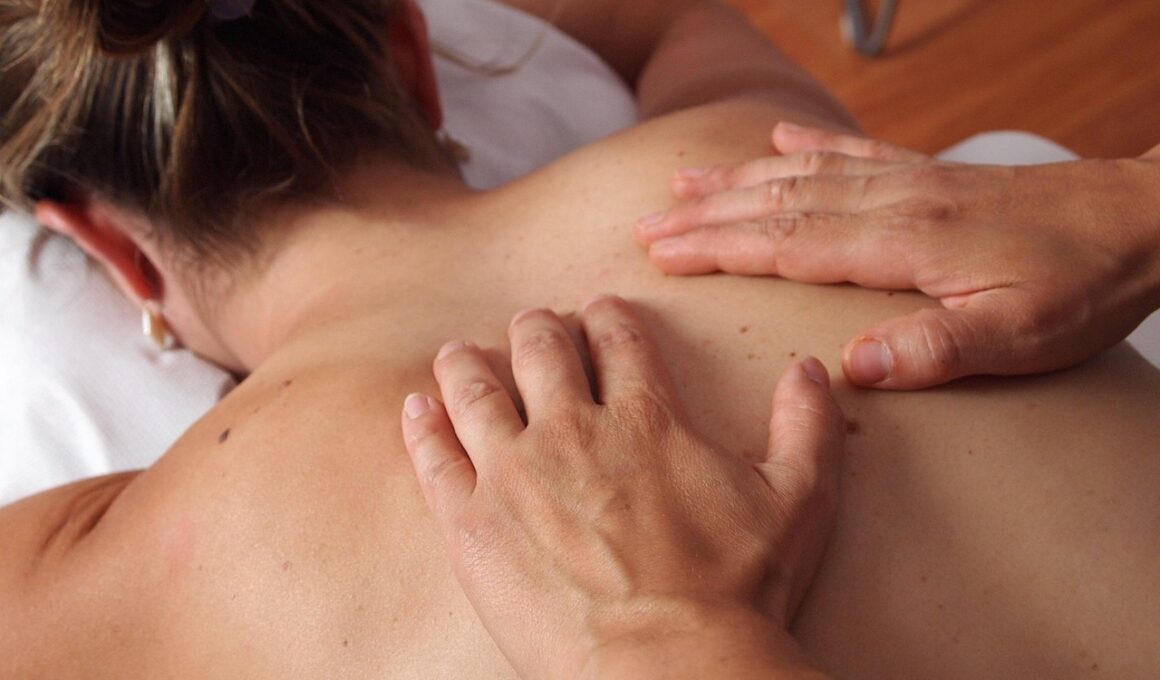The Role of Recovery in Wellness Competition Training
Recovery plays an essential role in the training regimen for wellness competitions. Athletes often push their limits, focusing on physical fitness and conditioning. However, without an appropriate recovery strategy, all the hard work may not yield desired outcomes. Adequate recovery allows the body to repair, rejuvenate, and restore energy levels. This is crucial for maintaining high performance levels, especially during intense training sessions. Athletes should understand that their bodies require time to heal and adapt to the stresses imposed by training regimens. Integrating recovery into a training plan promotes physical and mental health, ensuring that athletes stay motivated and engaged. It can take many forms, including rest days, active recovery sessions, and therapeutic practices. Moreover, sleep and nutrition significantly impact recovery efficiency. Therefore, a well-rounded approach that prioritizes recovery helps athletes perform at their peak. As athletes engage in wellness competitions, having a structured recovery schedule becomes increasingly important. Through systematic recovery, one can achieve balance in training and ensure longevity in fitness pursuits. Ultimately, the ability to recover is as critical as the training itself for achieving success in wellness competitions.
Types of Recovery Strategies
Various recovery strategies can significantly enhance an athlete’s performance in wellness competitions. Each individual’s recovery strategy may differ based on training intensity and personal needs. Active recovery involves low-intensity workouts that allow muscles to recover while maintaining some level of activity. Complementary techniques include stretching and foam rolling, which improve flexibility while alleviating soreness. Additionally, passive recovery focuses on complete rest, ensuring the muscles receive the necessary downtime to heal. Adequate sleep is fundamental for recovery, as it allows the body to repair tissues, regulate hormones, and replenish energy reserves. Nutrition also plays a crucial role in post-workout recovery, as consuming the right macronutrients supports muscle repair and growth. For instance, adequate protein intake aids in muscle recovery, while carbohydrates restore glycogen levels. Many athletes also find relief through massage therapy, which promotes blood flow and alleviates muscle tension. Furthermore, some alternative methods, like yoga and meditation, can enhance mental recovery. Combining these different strategies effectively addresses both the physical and mental aspects of recovery, leading to overall improved performance in wellness competitions.
Monitoring recovery metrics is essential for optimizing performance in wellness competitions. Incorporating tools like heart rate variability and subjective wellness questionnaires can provide valuable insights. Athletes should track how they feel both physically and mentally after training sessions. This data can help identify patterns related to fatigue and recovery. An effective monitoring strategy allows athletes to adjust their training loads. Overtraining can lead to burnout and injuries, making recovery metrics crucial for long-term success. Additionally, athletes should communicate openly with coaches about their recovery state. This collaboration enhances decision-making about training intensity and schedules. Incorporating recovery days into training plans is vital for allowing the body to heal and adapt. Coaches often schedule these strategically alongside high-intensity workouts. Furthermore, athletes can benefit from using relaxation techniques, including deep breathing and guided imagery, which support mental recovery as well. Self-care practices, such as massages or spa visits, also contribute to overall well-being. Regular assessment and fine-tuning of recovery practices are essential, as recovery needs might change over time. Therefore, understanding the importance of monitoring recovery metrics leads to improved performance and resilience in wellness competitions.
Nutrition and Recovery
Nutrition plays an integral role in enhancing recovery for wellness competition participants. Consuming a well-balanced diet directly influences muscle recovery and replenishment of energy reserves. After intense training, athletes need to refuel their bodies with carbohydrates and protein. Carbohydrates are vital for replenishing glycogen stores, while protein supports muscle repair and growth. Healthy fats also contribute to overall recovery by reducing inflammation. Staying hydrated is equally crucial, as fluid intake helps maintain performance and aids recovery. Nutritional timing should be considered to optimize recovery; athletes are encouraged to consume recovery meals or snacks within a two-hour window following training. Whole foods rich in vitamins and minerals, such as fruits, vegetables, and whole grains, support the body’s regeneration processes. Additionally, supplements like branched-chain amino acids and omega-3 fatty acids can complement dietary intake, enhancing recovery outcomes. Planning and preparing meals in advance can significantly improve adherence to nutritional strategies. Athletes should seek personalized nutrition plans to meet their specific training needs. Moreover, maintaining a food diary can help identify which foods positively impact recovery. Investing in proper nutrition strategies is critical for anyone serious about competing in wellness competitions.
Educating athletes about the importance of mental recovery in wellness competitions is imperative. Mental recovery can influence overall performance, as mental fatigue often accompanies physical exertion. Techniques such as visualization and mindfulness can aid athletes in achieving mental clarity and focus. Incorporating relaxation sessions into training can significantly reduce stress and anxiety related to competition. Engaging in hobbies unrelated to fitness can also benefit mental recovery, promoting a balanced life outside of competition routines. It is essential to create a supportive environment where athletes feel comfortable discussing their mental well-being. Additionally, fostering social connections with fellow competitors can provide emotional support during challenging periods. Mental coaches or sports psychologists can offer strategies to manage pressure and enhance resilience. Furthermore, prioritizing self-care activities contributes to increased motivation and improved mood. Regular check-ins can help athletes recognize signs of mental fatigue early on. By openly addressing mental health, athletes can enhance their overall reclaiming journey. Virtual support groups have also emerged as resources for connection and encouragement. Encouraging discussions about mental recovery fosters a culture of well-being, making it as crucial as physical recovery in wellness competitions.
Rest and Training Balance
For wellness competition athletes, striking the right balance between training and rest is crucial for optimal performance. Overemphasis on training can lead to fatigue, burnout, and decreased motivation. Incorporating strategic rest days helps the body recover from rigorous workout regimes, thereby positively impacting performance. It is essential for athletes to listen to their bodies and recognize when they need additional rest. Training schedules should also integrate lighter training days, allowing for reduced intensity workouts. Customized recovery protocols can be established, enhancing performance without risking injury. Maintaining this balance facilitates emotional resilience, promoting mental clarity amidst physically demanding schedules. Additionally, scheduling regular reassessments of the training plan with input from coaches can guide adjustments. Flexibility in training schedules encourages adherence, as life events may affect training plans. Learning to prioritize rest effectively enhances recovery outcomes and energy levels. Socially, athletes can benefit from participating in group activities that foster connections during periods of rest. Lastly, respecting the body’s need for recovery strengthens the commitment towards achieving wellness competition goals. Thus, understanding the importance of rest as a part of training can uplift athletes’ performance levels sustainably.
Finally, the relationship between recovery and overall athletic performance in wellness competitions cannot be overstated. Individuals aspiring to compete must contribute an adequate amount of time towards recovery practices. Enhancing recovery involves focusing on physical, mental, and nutritional aspects. As athletes progressively increase their training intensity, they should not overlook the necessity of incorporating various recovery modalities. Self-care techniques, such as soaking baths and yoga, can help alleviate physical soreness and ensure a holistic recovery approach. Recovery should be celebrated, not viewed as weakness; it is an investment in long-term performance. In conclusion, a comprehensive recovery plan focused on personalized needs will ensure a successful wellness competition journey. Engaging various recovery strategies opens avenues for continuous improvement while fostering a positive mindset. Athletes should seek balance in training and rest, and prioritize nutrition, hydration, and mental well-being. By doing so, participants can enhance their competition readiness and sustain peak performance levels. As wellness competitions continue to evolve, prioritizing recovery remains a non-negotiable aspect of training for any competitive athlete. Ultimately, it speaks volumes about an athlete’s commitment to excellence and their longevity in the sport.
Conclusion
The essence of recovery in wellness competition training is paramount for long-term success and health. Athletes must recognize that intensive training alone does not lead to peak performance; a thoughtful recovery strategy is equally vital. Integrating structured recovery practices can significantly enhance not only performance outcomes but also overall well-being. This profound understanding cultivates enthusiasm and passion for the sport by reducing physical and emotional burnout. Competitors should prioritize finding a balance between discipline in training and the necessity of rest and recovery. Therefore, they are encouraged to stay educated on recovery strategies, leading to informed decisions regarding their wellness journey. With appropriate strategies, participants can create a sustainable training environment where they thrive. Adjusting training regimens based on recovery feedback will give participants the advantage of maximizing performance during competitions. Furthermore, building a supportive community among athletes fosters shared learning and personal growth in recovery journeys. Cultivating these relationships can provide motivation during challenging moments. In summary, dedicating time to recovery routines and strategies ultimately positions athletes for success in wellness competitions, ensuring they shine on competition day. Thus, the role of recovery in wellness training cannot be underestimated or neglected.


